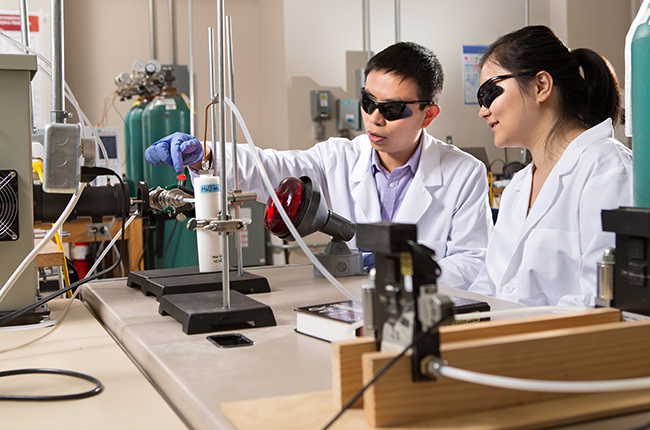Researchers with the Department of Mechanical Engineering at Texas A&M University are making the best use of our energy waste — turning one of our most potent pollutants and greenhouse gasses, carbon dioxide (CO2), into hydrocarbon fuels that can help the environment and solve growing energy needs.
“We’re essentially trying to convert CO2and water, with the use of the sun, into solar fuels in a process called artificial photosynthesis,” said Dr. Ying Li, associate professor of mechanical engineering and principal investigator. “In this process, the photo-catalyst material has some unique properties and acts as a semiconductor, absorbing the sunlight which excites the electrons in the semiconductor and gives them the electric potential to reduce water and CO2 into carbon monoxide and hydrogen, which together can be converted to liquid hydrocarbon fuels.”
The first step of the process involves capturing CO2from emissions sources such as power plants that contribute to one-third of the global carbon emissions. As of yet, there is no technology capable of capturing the CO2, andat the same time re-converting it back into a fuel source that isn’t expensive. The material, which is a hybrid of titanium oxide and magnesium oxide, uses the magnesium oxide to absorb the CO2 and the titanium oxide to act as the photo-catalyst, generating electrons through sunlight that interact with the absorbed CO2 and water to generate the fuel.
Plugging The Leaks: Research Aims To Prevent Nuclear Waste Seepage
The project is still in the fundamental research stage. One of the challenges with this technology is that the current conversion efficiency of converting CO2and water into renewable solar fuels remains low, less than a few percent. According to Li, the conversion process also takes considerable time and the material can only absorb a fraction of the emitted sunlight. For Li and his team, solving these issues revolves around engineering more efficient materials with nano-scale structures and advancing the reactor design so that the materials placed within the reactor can absorb sunlight in the most efficient manner.
“There are also other considerations,” said doctoral student Huilei Zhao, a student contributing to the ongoing research in Li’s research group. “Concentrated sunlight exposure can lead to a higher conversion efficiency and we’ve found that if we operate at a higher temperature with this reaction, the conversion efficiency can be dramatically increased.”
The project is a part of a five-year research grant and CAREER Award for Li from the National Science Foundation, and is currently in its third year. By the end of the project, Li hopes to have developed a higher level of conversion efficiency and determine if the process can be commercially viable.
“There are two different ways to quantify the efficiency,” said Li. “What is the fraction of the solar energy we are storing into fuels, or what is the fraction of CO2 being converted to fuels? In either case, we need to achieve a near 10-percent efficiency to make the process economically competitive.”
Li explains that the commercial viability of this material is crucial, and while fossil fuels such as oil and natural gas remain cheap, low conversion rates do not serve to make the material attractive in meeting national energy needs. He says, however, that too many people are thinking in the short term.
“We may think in the current stage that this technology is not competitive with fossil fuels,” Li said. “But, if we think in the long run, our fossil fuels can only support our energy needs for maybe a couple hundred years if we use them at the current rate. What will happen after that? We will still need these liquid hydrocarbon fuels to power our machines, vehicles and airplanes. Electricity made through renewable resources alone will not be enough because we cannot store and transport it effectively. Therefore, we believe this new technology of producing renewable hydrocarbon fuels is important in dealing with both global climate issues and our need for sustainable energy.”
###
This story by Robert Scoggins was originally posted on the College of Engineering website.






